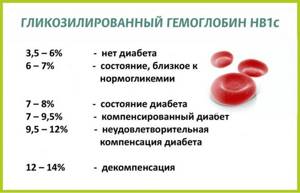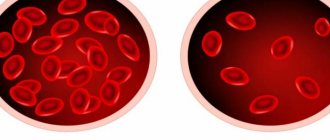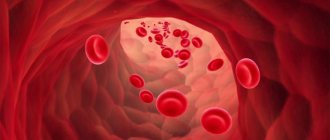Glycated hemoglobin is one of the indicators of a biochemical blood test. Allows you to determine the average blood sugar level over the past three months. In tests it may be referred to as HbA1C or A1C.
Knowing its significance is important in order to promptly identify diabetes mellitus, monitor the course of the disease and the effectiveness of the therapy used.
How to understand the results of the analysis?
The normal value of glycated hemoglobin is 4-6%.
A value of 6.5% or higher means you are likely to have diabetes. To make a diagnosis, you need to take blood tests for sugar on an empty stomach and after eating.
6.0-6.5% is typical for prediabetes, in this case it is better to conduct an additional examination - a sugar curve.
There are a number of situations when a blood test for glycated hemoglobin is not informative. This happens with anemia of various origins, after blood transfusions. In the onset of type 1 diabetes, which sometimes develops very quickly, glycated hemoglobin does not have time to increase despite very high blood sugar levels.

For patients with diabetes mellitus, the norms of glycated hemoglobin are different. The target value is determined individually by the attending physician; it depends on the patient’s age and the presence of severe complications of diabetes mellitus. Most diabetic patients are advised to keep their glycated hemoglobin level below 7.0%. For young patients without severe complications and without severe hypoglycemia, stricter control is recommended - glycated hemoglobin not higher than 6.5%. For elderly patients, patients with severe complications of diabetes or severe comorbidities, the target level is considered to be 7.5%.
Why check glycated hemoglobin when you can just measure your blood sugar?
Blood sugar is not a constant value; it changes all the time. In the morning after an overnight fast, blood sugar is low, after eating it rises sharply, then gradually decreases. By determining fasting blood sugar, we only know the sugar at a specific moment, but we know nothing about its daily fluctuations. In patients with diabetes, with poorly selected therapy or with a gross violation of the diet, blood sugar during the day can change by 15-20 mmol/l!
The level of glycated hemoglobin reflects all these sugar fluctuations. If a patient with diabetes mellitus rarely measures their blood sugar, then by looking at the level of glycated hemoglobin, the doctor can judge how high the person's sugar level has been on average in the last 2-3 months. Often, a blood test for glycated hemoglobin helps the doctor decide whether to change the treatment regimen of a patient with diabetes.
A blood test for glycated hemoglobin is important when diagnosing diabetes mellitus. At the beginning of the disease, it often happens that fasting blood sugar remains within normal limits, but sugar after eating increases significantly, which the person does not know about. An increased level of glycated hemoglobin in this situation will tell the doctor that additional examination should be prescribed and will help identify the disease.
Additional events
The list of items included in the research and mandatory can be expanded and supplemented. This depends on such indicators as the patient’s place of residence, his age, and lifestyle.
Recommendations could be:
- determination of the state of the thyroid gland. Tests of this type are required for those who live in areas with a natural iodine deficiency. The examination will assess the functional characteristics of the gland and determine the amount of hormones produced. If necessary, therapeutic measures will be taken to minimize the occurrence and possible development of various types of complications. In the case of normal functioning of the thyroid gland, blood is donated for hormones annually and this is quite enough. If there are deviations from the norm, the frequency is determined by the doctor;
- blood test for HIV, hepatitis of various types is a relevant procedure for people who often undergo dental treatment, who have undergone major operations, fans of tattoos and those who lead a promiscuous sex life with frequent changes of partners. How much a person cares about his health depends on himself, but it is still necessary to be diagnosed once or twice a year.
In what cases is a study prescribed?
The reason for prescribing the analysis is diagnosed bone marrow diseases, as well as general symptoms of anemia:
- pallor of the skin and mucous membranes (conjunctiva, gums, tongue);
- unjustified weakness;
- fast fatiguability;
- rapid pulse (lack of oxygen causes the heart to pump blood harder).
During a general examination, you should pay attention to specific symptoms characteristic of a particular type of anemia:

- brittle hair and nails (iron deficiency anemia);
- bright crimson tongue (B12 deficiency anemia);
- yellowness of the skin and eye sclera (hemolytic anemia)
A routine analysis of hemoglobin levels is carried out for a comprehensive assessment of the condition during pregnancy, before bone marrow transplants or interventions affecting the hematopoietic organs. Periodic monitoring requires hormonal therapy (primarily with erythropoietin preparations), as well as long-term use of iron-containing drugs.
How often should you get tested?

Few people have perfect health. Living and working conditions, bad habits and the environment leave much to be desired, and hereditary factors can also cause diseases. Often, even those who are 100% confident in their absolute health do not know the true picture, because pathological processes can take a long time and be asymptomatic.
In order to determine predisposition to the disease or identify it at the initial stage, it is necessary to conduct periodic medical examinations, one of the parts of which is taking various types of tests.
Most doctors agree that for patients under the age of 40, in the complete absence of any complaints, it is enough to donate blood once every two years, and for the older category, once a year. For children, the frequency is completely different. The first time blood is taken at birth, then a month later, then it is recommended once every three months until the age of 3, after which the analysis is taken annually, like for all other categories of citizens.
When choosing a laboratory for testing, you must be guided by some criteria, namely:
- The best option for carrying out manipulations is the use of new type vacuum tubes. They are optimal in terms of safety criteria for the laboratory assistant and the patient, while ensuring the best safety of the sample taken.
- When taking blood, find out if the tubes have a bar code to eliminate the possibility of mixing up patient biomaterials.
- Also an important factor will be the reputation of the institution, which can be objective and unbiased. Technical equipment plays an important role. Today, the presence of modern equipment will not only guarantee the correct diagnosis, but also compliance with safety rules that exclude infection of the patient or health care worker.
In the medical laboratory you can take all types of medical tests. We guarantee reliable and fast results.
You can take medical tests at the following address: st. Lesnaya, house 2.
tell friends
Blood chemistry

This type of research provides much more information than a general blood test, since it determines metabolic indicators by which one can judge the functioning of the organs of the whole body. Thus, the content of all blood components is determined. There are no strict criteria in biochemical analysis, so only the attending physician can draw any conclusions; he evaluates the ratio of the obtained indicators.
The results can include data on liver enzymes and cholesterol, protein and glucose, urea and other components present in the blood. Depending on their percentage, the quality of metabolism is determined, the body’s predispositions to various kinds of diseases are identified and some of them are identified.
By evaluating medical tests, the doctor is able to diagnose abnormalities in the cardiovascular system, diseases of the pancreas and liver, gall bladder and kidneys. Biochemistry also provides an assessment of the amount of microelements and their qualitative ratio.
Blood is taken from the ulnar vein and given in the morning on an empty stomach strictly as prescribed by the doctor.









